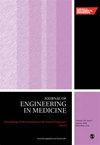Effect of anterior cruciate ligament injury on acceleration response of knee joint
IF 1.7
4区 医学
Q3 ENGINEERING, BIOMEDICAL
Proceedings of the Institution of Mechanical Engineers, Part H: Journal of Engineering in Medicine
Pub Date : 2024-04-09
DOI:10.1177/09544119241242968
引用次数: 0
Abstract
This study investigated the effect of anterior cruciate ligament (ACL) injury on relative acceleration of the tibia and femur during a number of tests/activities, in order to assess the feasibility of acceleration-based diagnosis of ACL injury using inertial sensors. First, a detailed finite element model of the knee joint was developed to simulate the target tests/activities, and identify those in which a large difference between the maximum acceleration peaks (MAPs) of the healthy and ACL injured knees is likely to be observed. The promising tests/activities were entered in an experimental study, where the relative accelerations of the tibiae and femurs of 20 individuals with unilateral ACL injury, allocated randomly to two groups of conscious and unconscious test conditions, were recorded. Model predictions indicated MAP ratios>1.5 for the ACL-injured to healthy knees, during the anterior drawer, Lachman, and pivot-shift tests, as well as the lunge activity. The experimental MAP results indicated acceptable test–retest reliabilities for all tests (coefficient of variation<0.25), and significant MAP differences ( p < 0.05) in the anterior drawer and pivot-shift tests, in both coconscious and unconscious conditions. The individualized MAP results indicated side-to-side differences>2 m/s前十字韧带损伤对膝关节加速度反应的影响
本研究调查了前十字韧带(ACL)损伤对一些测试/活动中胫骨和股骨相对加速度的影响,以评估使用惯性传感器对前十字韧带损伤进行加速度诊断的可行性。首先,建立了详细的膝关节有限元模型,以模拟目标测试/活动,并确定健康膝关节和前交叉韧带损伤膝关节的最大加速度峰值(MAP)之间可能存在较大差异的测试/活动。在一项实验研究中,对 20 名单侧前交叉韧带损伤患者的胫骨和股骨的相对加速度进行了记录,这些患者被随机分配到有意识和无意识两组测试条件中。模型预测表明,在前牵引、拉赫曼和枢轴移位测试以及腾空活动中,前交叉韧带损伤膝关节与健康膝关节的 MAP 比率为 1.5。实验性 MAP 结果表明,所有测试的重复测试可靠性均可接受(变异系数为 0.25),而在前牵引和枢轴移位测试中,无论是在有意识还是无意识状态下,MAP 都存在显著差异(p 为 0.05)。个体化的 MAP 结果表明,在无意识的枢轴移位测试中,所有受试者的侧对侧差异为 2 m/s2,而在有意识的前牵引测试中,10 个受试者中有 8 个受试者的侧对侧差异为 0.5 m/s2。结论是,在无意识状态下,枢轴移位测试具有很高的重复性和基于加速度诊断前交叉韧带损伤的鉴别能力。然而,在有意识的情况下,前牵引试验似乎最有前途。
本文章由计算机程序翻译,如有差异,请以英文原文为准。
求助全文
约1分钟内获得全文
求助全文
来源期刊

CiteScore
3.60
自引率
5.60%
发文量
122
审稿时长
6 months
期刊介绍:
The Journal of Engineering in Medicine is an interdisciplinary journal encompassing all aspects of engineering in medicine. The Journal is a vital tool for maintaining an understanding of the newest techniques and research in medical engineering.
 求助内容:
求助内容: 应助结果提醒方式:
应助结果提醒方式:


